
current / archive / issues / faq / RSS feed / twitter /
Trapped In Doomsland!
| < previous | next > |
 Doom has his own ongoing story in Astonising Tales during this period, but the fact that that only comes out every other month means that there's plenty of time for Stan Lee to continue with his own version of the character in the second part of a two-parter in Thor.
Doom has his own ongoing story in Astonising Tales during this period, but the fact that that only comes out every other month means that there's plenty of time for Stan Lee to continue with his own version of the character in the second part of a two-parter in Thor.
The story picks up right where the last issue of Thor left off, with the Thunder God being chased by a guided missile. Rather than risk the Latverians below he throws his hammer Mjolnir into the sky, so that the missile will follow that instead. The plan works, but without his hammer Thor crashes to the ground and, after sixty seconds (non) hammer time he transforms back into his human form as Don Blake.
The hammer lands nearby, and the locals wonder whether to go and find it.
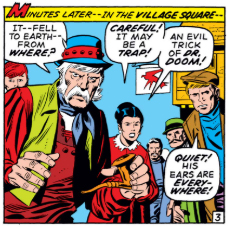 Here we see again how the Latverian people's attitude to Doom has changed. Where once they saw him as a benevolent leader, now he is the head of a terror state with eyes and ears everywhere on his frightened people.
Here we see again how the Latverian people's attitude to Doom has changed. Where once they saw him as a benevolent leader, now he is the head of a terror state with eyes and ears everywhere on his frightened people.
Doom's own delusion about this is shown yet again, believing his own lies about what a kindly ruler he is. "I merely sought to protect you all!" he says after shooting at them with his finger lasers, before attempting to gain the hammer for himself, under the guise of keeping his people safe.
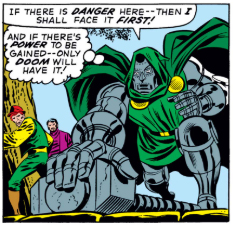 Of course, Doom is not worthy to lift the hammer, so he places it under a protective force field and then stomps back to his lab to set his robot hounds to find the missing Don Blake.
Of course, Doom is not worthy to lift the hammer, so he places it under a protective force field and then stomps back to his lab to set his robot hounds to find the missing Don Blake.
After a brief interlude in Asgard, where we see Odin watching the proceedings, we catch up with Don Blake who has managed to find the missing Professor La Farge, father of Cosette who he promised to help last time. To Blake's surprise the Professor does not want to come with him, apparently convinced that it's a trap set by Doom.
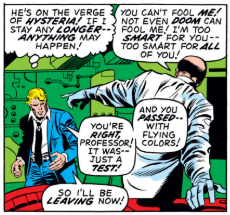 Blake returns to the town square, where he tricks some of Doom's soldiers into blasting a hole in the ground near the hammer. The guards trot off to report their good work to their masters, leaving Blake able to jump into the hole, dig around the edge of the force field and up through the paving slabs, to grab hold of the hammer and turn into Thor again. This whole bit is massively silly - why did they wander off without checking for a body and why did Doom only make the force field semi-circular? - but it does at least get the comic's title character back into action. He flies back into the castle, only to find Doom waiting for him in a fantastic depiction by John Buscema that was destined to be re-used several times for merchandise and advertising.
Blake returns to the town square, where he tricks some of Doom's soldiers into blasting a hole in the ground near the hammer. The guards trot off to report their good work to their masters, leaving Blake able to jump into the hole, dig around the edge of the force field and up through the paving slabs, to grab hold of the hammer and turn into Thor again. This whole bit is massively silly - why did they wander off without checking for a body and why did Doom only make the force field semi-circular? - but it does at least get the comic's title character back into action. He flies back into the castle, only to find Doom waiting for him in a fantastic depiction by John Buscema that was destined to be re-used several times for merchandise and advertising.
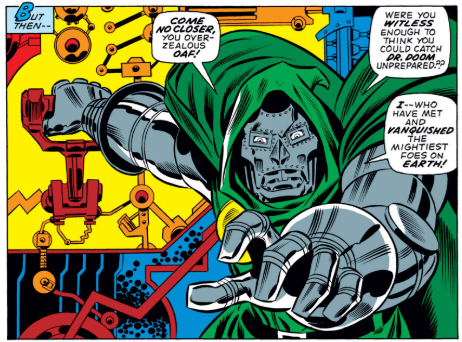 Thor tricks Doom into taking Mjolnir, which he is again unable to hold onto. Unfortunately this leaves Thor weaponless and with only sixty seconds to get the hammer back before he transforms once again. Thor is often spoken of as the most powerful character in the Marvel Universe - the only one, for instance, who could conceivably fight DC's Superman - but Doom puts up a good fight here and almost overpowers him, only losing out due to some loose flooring titles.
Thor tricks Doom into taking Mjolnir, which he is again unable to hold onto. Unfortunately this leaves Thor weaponless and with only sixty seconds to get the hammer back before he transforms once again. Thor is often spoken of as the most powerful character in the Marvel Universe - the only one, for instance, who could conceivably fight DC's Superman - but Doom puts up a good fight here and almost overpowers him, only losing out due to some loose flooring titles.
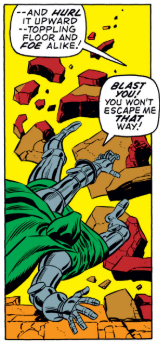 Thor flies out and destroys a whole bunch of missiles - the very missiles that Professor La Farge has spent all these years building - before zooming back to collect the kidnapped scientist. However, when he does, he's in for a rather nasty surprise.
Thor flies out and destroys a whole bunch of missiles - the very missiles that Professor La Farge has spent all these years building - before zooming back to collect the kidnapped scientist. However, when he does, he's in for a rather nasty surprise.
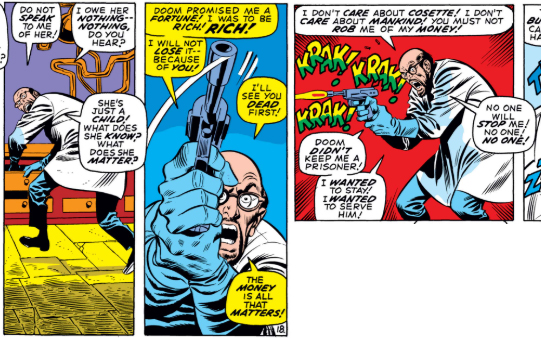 Whoa! So Cosette's version of events was untrue all along - a child's imaging of what had happened, designed to cast her father in a good light whilst all along he was happily in league with Doctor Doom!
Whoa! So Cosette's version of events was untrue all along - a child's imaging of what had happened, designed to cast her father in a good light whilst all along he was happily in league with Doctor Doom!
The Professor accidentally kills himself in a hail of bullets directed at Thor, and dies cursing his daughter's name. Thor leaves the area, more worried about how he's going to explain all of this to Cosette than the threats hurled at him by a furious Doom.
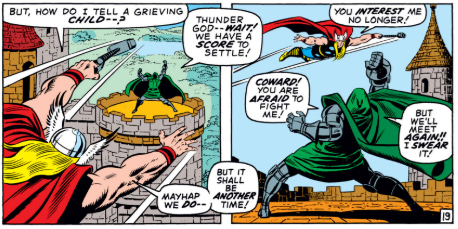 The story ends with Thor back in Manhattan, forced to tell Cosette that his daughter is dead, and coming up with a rather clever way of telling her what happened.
The story ends with Thor back in Manhattan, forced to tell Cosette that his daughter is dead, and coming up with a rather clever way of telling her what happened.
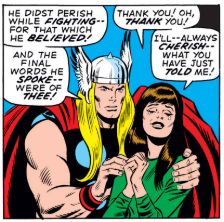 It's all true! As I've said in other recent blogs, it's easy to mock Stan Lee's writing sometimes, but things like this remind you of why he was so successful. It's been an exciting story with moral twists and turns, helped along the way by some gorgeous art by John Buscema. It also includes coherent characterisation of Doom which follows on, and builds upon, the work Stan Lee has done on the character since his creation. The only problem, as we shall see in the next blog, is that it no longer lines up with how other creators are depicting him!
It's all true! As I've said in other recent blogs, it's easy to mock Stan Lee's writing sometimes, but things like this remind you of why he was so successful. It's been an exciting story with moral twists and turns, helped along the way by some gorgeous art by John Buscema. It also includes coherent characterisation of Doom which follows on, and builds upon, the work Stan Lee has done on the character since his creation. The only problem, as we shall see in the next blog, is that it no longer lines up with how other creators are depicting him!
link to information about this issue
posted 11/10/2018 by Mark Hibbett
| < previous | next > |
Comments: